20+ SAMPLE Restaurant Notice
-
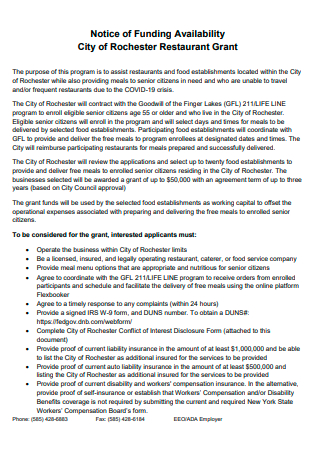
Restaurant Grant Notice
download now -
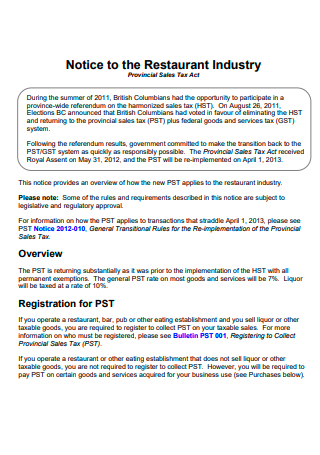
Restaurant Industry Notice
download now -

Restaurant Promotion Commission Public Meeting Notice
download now -
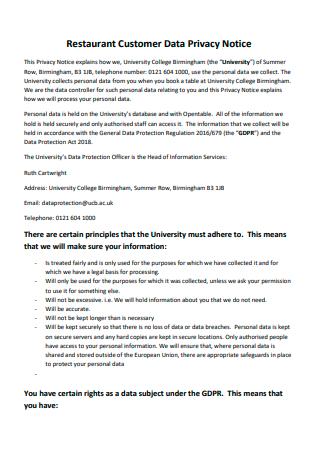
Restaurant Customer Data Privacy Notice
download now -

Restaurant Concession Notice of Request For Proposal
download now -
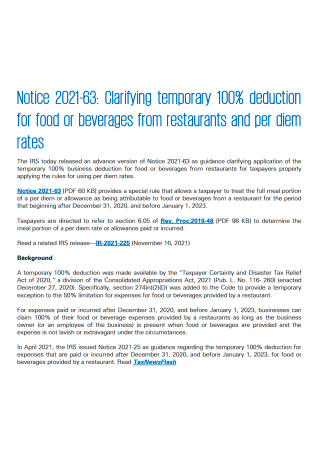
Standard Restaurant Notice
download now -
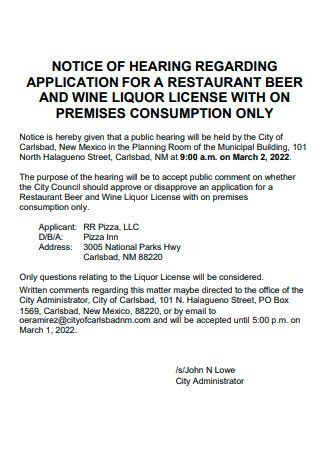
Application For Restaurant Beer and Wine Notice
download now -
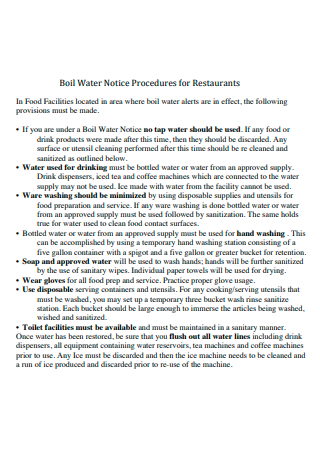
Restaurant Boil Water Notice
download now -
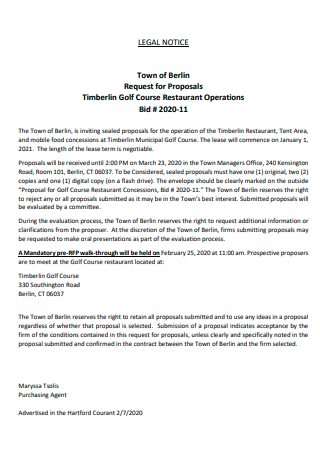
Restaurant Operations Legal Notice
download now -
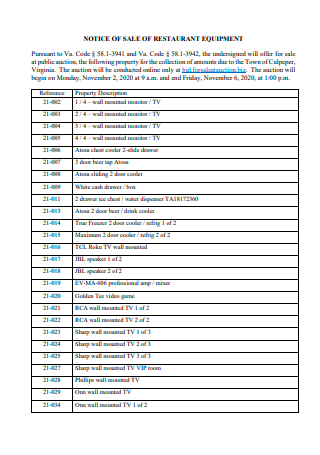
Restaurant Equipment Notice of Sale
download now -
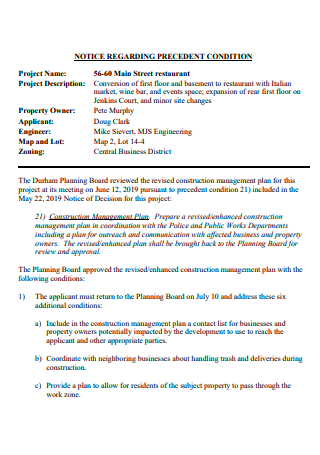
Street Restaurant Notice
download now -
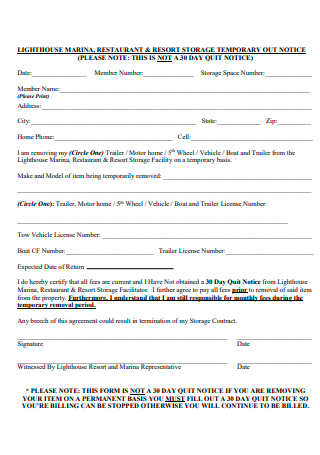
Restaurant and Resort Storage Temporary Out Notice
download now -
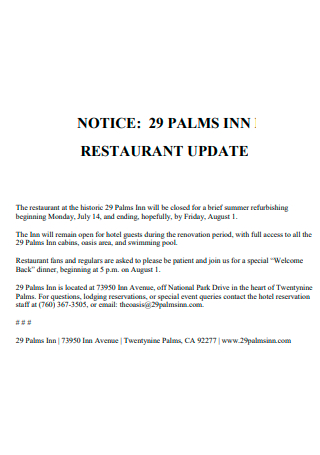
Restaurant Update Notice
download now -
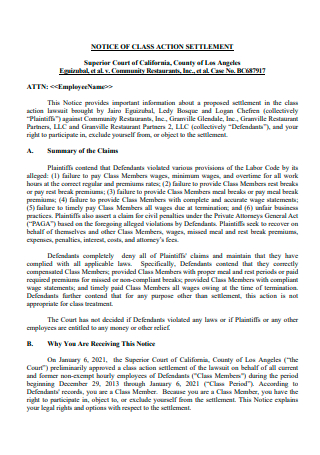
Community Restaurant Notice
download now -
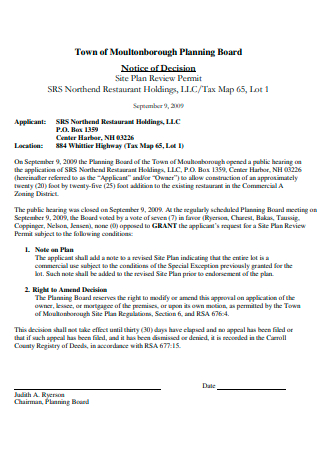
Restaurant Holdings Notice of Decision
download now -
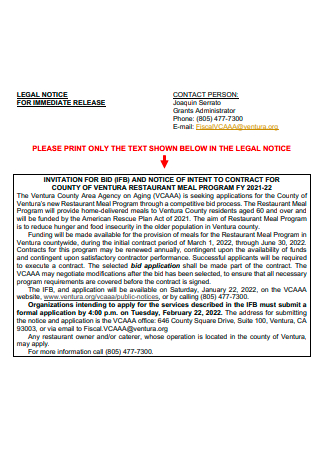
Restaurant Meal Program Notice
download now -
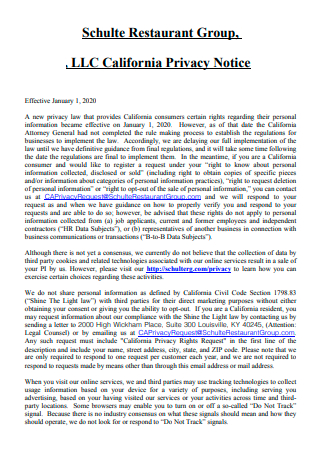
Restaurant Group Privacy Notice
download now -

Restaurant Hours Notice of Changes Template
download now -

Restaurant Notice of Class Action Settlement
download now -

Restaurant Group Notice of General Meeting
download now -
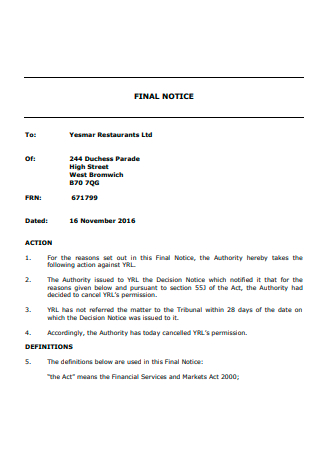
Restaurant Final Notice
download now
FREE Restaurant Notice s to Download
20+ SAMPLE Restaurant Notice
What Is a Restaurant?
Benefits of Restaurant Employee Management
Tips To Attract Families to Your Restaurant
How To Open a Restaurant
FAQs
Why do restaurants target families?
How has fast food been advertised?
Who are the target customers of a restaurant?
What Is a Restaurant?
A restaurant is a business that organizes and serves guests food and beverages. Generally, meals are served and consumed on the premises; however, many restaurants now provide takeout and delivery. Restaurants vary widely in look and offerings, including various cuisines and service styles ranging from economical fast-food restaurants and cafeterias to upscale luxury places. The failure rate of restaurants is difficult to quantify on a national scale, although it is estimated to be 30% in the restaurant business. In other words, one in three restaurants will fail within their first year of operation.
Benefits of Restaurant Employee Management
Running a restaurant is already busy, so why not make the day-to-day tasks easier by setting up a system to help you out? There are a lot of things that diners have to do every day. These include scheduling employees, taking care of HR, keeping track of employee attendance, and getting ready for payroll. These are a few reasons a restaurant might need an employee management system. No one wants to handle these things by hand because it takes too much time and can be very frustrating for the person in charge. Restaurant employee management systems turn these problems around and make them much easier to handle. Your employees and managers will be much happier when they can focus on their jobs instead of wasting time on these tasks. Check why you should buy an employee management system if you need to change how your restaurant works.
Tips To Attract Families to Your Restaurant
Due to their independent nature, children can be fussy eaters and generate a commotion when dining out. Therefore, families with children will carefully select a dining location to ensure the comfort of their children and avoid any problems. You can apply extraordinary kid-friendly restaurant ideas as a restaurant owner who wishes to attract families with children. Let’s examine a few of them.
1. Provide a warm greeting
One of the first things a family will notice upon entering your restaurant is how you greet them. A pleasant, bright smile from your waitress or whoever is responsible for greeting guests will determine whether you will attract or repel new customers with children. When welcoming clients to your restaurant, you should strive to make them feel comfortable and at ease. Families require a warm welcome since parents are cautious about where they bring their children. They will need relief from you and your team that everything will be alright.
2. Develop a kid-friendly menu
A menu is like a website landing page. It conveys your objectives, mission and vision, and character to your customers. After warmly welcoming customers to your restaurant, you should ensure that your menu is suitable for all family members, especially children. Typically, children enjoy meals that are designed just for them. With this in mind, prepare nutritious meals that capture the children’s attention. As their bodies are still developing, children must consume healthful foods. Parents are concerned about this factor as well. If they realize that the food you serve is healthy and appealing to children, it’s a win-win situation. You ponder how to make the meals more enticing to children. They can be formed into animals, flowers, and animated figures.
3. Purchase suitable furnishings and equipment
You cannot expect children to utilize the same serving utensils and flatware as adults. The furniture and utensils used by children must be sturdy and resilient to survive their activity. If you own a restaurant that welcomes children, you should provide plastic utensils, glasses, and plates for the children so that parents may relax. However, ensure that they are not readily broken.
4. Add a children’s area and maintain it tidy.
In a restaurant that welcomes children, a “kids’ section” where they may play with toys and other children is a fantastic concept. Thus, they can expend energy before and after feeding. However, remember that children tend to put whatever they find in their mouths. The area’s toys, equipment, and other attractions must be clean to prevent children from eating germs and dirt. Parents will be pleased and remember your restaurant if the children’s room is clean.
5. Host children’s events and utilize social media
Children and enjoyment are two words that cannot be separated. Hosting parties where children may participate in enjoyable activities can assist in creating lasting memories for them and their families. If executed well, this will also distinguish your restaurant from others. If the children love these activities, they will pester their parents to dine at your establishment. They will soon become regulars. Also, social media has changed through time and is ingrained in nearly every aspect of our lives. Any firm can benefit from posting helpful information and updates on the web. To attract young families with children, promote your child-friendly services on popular social media platforms such as Facebook and Instagram. If you lack the time, you may consider hiring a social media specialist who can prioritize your accounts.
6. Optimize your menu for online ordering
Technology has penetrated the food business, which can be utilized for various purposes. Ordering food is now the standard since it is simple, convenient, and stress-free. In addition, the epidemic increased the demand for restaurants that deliver. Thus, internet orders have become integral to your restaurant’s operations. However, not all menu items travel well, so you must modify your menu for delivery. Only deliver items that cannot be damaged during shipping. To attract families with children, sell family-friendly menu bundles and meal packages. To improve sales, offer a user-friendly and easily navigable online ordering system or app.
How To Open a Restaurant
Before opening your restaurant, you must be familiar with the necessary business components. Consider working or shadowing in a restaurant or food service environment to understand how the business runs and what elements are required for success. Follow these steps to establish your restaurant:
1. Determine your concept and market
Your restaurant’s concept is the type of facility you intend to build, including the type of food served, the level of service offered, and the ambiance you intend to give to your clients. Consider the cuisine you would like to provide, such as American, Italian, Mexican, or Asian foods. Once you have an idea of the food you wish to serve, you should evaluate the style of the restaurant and the ambiance you prefer. This establishment could be a diner, fine dining, or bar. Understanding the basic concept of your restaurant is a terrific beginning point for developing the rest of its plans.
2. Choose your location and design
As you look for a place to open your restaurant, check out the neighborhood to ensure it’s a good fit. Find out if there are a lot of possible customers living nearby. You should also look around the building to see if there are enough parking spots for all of your customers to find and use easily. Find out more about the building’s and the building next door’s previous owners and if other restaurants or similar businesses used to be there. If they closed, ask the owner of the property or the people who live nearby what happened. This helps you figure out if there are any risks to opening a business there. Once you’re happy with the location, check the inside of the building to ensure it has enough space for everything you want, like a waiting area, a bar, refrigerators, seating, and restrooms.
3. Select the brand and name of the restaurant
Choose the restaurant’s brand before deciding on its name. A restaurant’s brand is the mental image you want patrons to have when considering your establishment. You may effectively communicate your company’s brand through your language, visuals, mission statement, and company values. Choose the business’s principles and mission you wish to promote to the public. Choose a name that communicates the restaurant’s image, style, and purpose. It can be something personal to you or a pun relating to the business’s topic or identity. Ensure that your company’s name is distinct yet straightforward for people to grasp, identify, and pronounce.
4. Research your target demographic
Knowing your restaurant’s theme, location, and brand may better determine the audience you wish to attract. Analyze the demographics of the area surrounding your new site. You can obtain this information by conducting an area survey, conducting online research on the population, and speaking with community people. Determine the types of residents in the region, such as families, elders, and younger couples. Utilize this information to construct a restaurant specifically designed to attract them. For instance, if you are opening a diner close to a fitness club and discover that many locals value healthy eating and organic foods, you should include these things on the menu and advertise them to this demographic.
5. Build a business plan
A restaurant business plan is a document for investors to evaluate that details the various parts of the business. It should assist you in defining the essentials of your restaurant, from the concept to the plan for generating consistent revenue. When applying for various small business loans, utilize this paper to describe your company and your strategy for achieving success.
6. Design your menu
Knowing your concept, brand, and place makes it simpler to create your menu and select which foods to sell. Customers should be able to efficiently read your menu, featuring a clean style and cuisine descriptions. Include a plain font and paper that is resistant to damage and tearing. Ensure that your menu caters to your primary demographic. For example, if your target market is relatives, you should provide a children’s menu with products they appreciate. For luxury eateries, offer a comprehensive wine list.
7. Acquire restaurant equipment, register your eatery, and acquire the required licenses.
Choosing which menu items to feature can assist you in choosing the appropriate equipment, inventory, and budget. Begin by compiling a list of the essential equipment items for a general restaurant. This could include ranges, ovens, and refrigerators. Depending on the food you serve, you may require extra supplies. For instance, launching an Italian restaurant requires a pasta maker. One must acquire a pizza oven and significant quantities of dough and flour for pizzerias. Also, To become an official and legal business, you must register your company with the state and acquire the appropriate operating licenses. Apply for a business license to verify that your operations are permitted. Depending on your state, the fee and type of support you must obtain can vary. Investigate your state’s requirements to determine your needs. Apply for an employee identification number to become an official business and to have the authority to hire employees and establish payrolls. To serve food lawfully in your restaurant, you must apply for a food service license. Before issuing you this license, an inspector will visit your restaurant to verify that it complies with all applicable food and safety regulations. Suppose you choose to serve alcohol at a restaurant. In that case, you must also apply for a liquor license by researching your state’s liquor laws, submitting the necessary documentation, and paying the licensing cost.
FAQs
Why do restaurants target families?
Family-style restaurants are well-known for characteristics that are especially appropriate to family dining, namely courteous service, a welcoming ambiance, and features that specifically appeal to parents dining with their children.
How has fast food been advertised?
Direct mail advertisements for fast food are frequently sent in envelopes of vibrant color and feature coupons or discounts. Commercials on television are often the most seen type of fast food advertising. Food firms make commercials that advertise their products and place the ads during intense audience hours.
Who are the target customers of a restaurant?
Your target client is the person who is most likely to frequent and support your restaurant. Several methods satisfy your target client, whether it’s your menu, your restaurant’s concept, or the whole guest experience.
It is essential for individuals in charge of all restaurant-related concerns to be able to discuss critical issues that could affect the entire restaurant whenever they arise. With this restaurant notice, you can ensure that they do so by informing them of what they must discuss and when they must do so.
